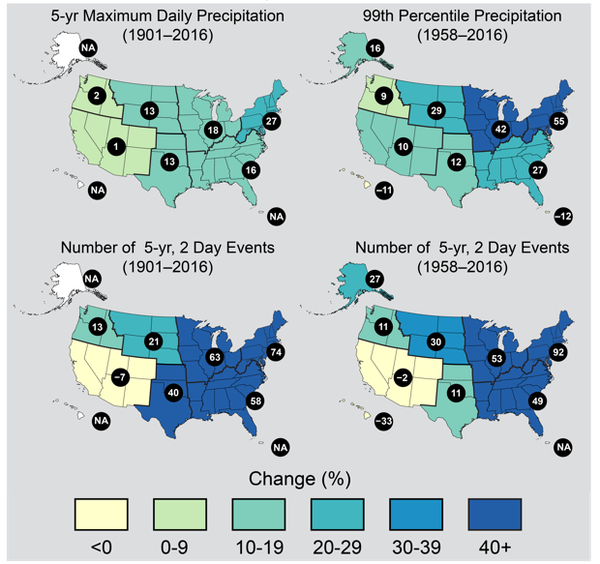Even if you can’t see a waterway from your front door, it’s important to be aware of the potential for flooding in your area. As FEMA’s David Maurstad told the New York Times, “Where it can rain, it can flood.” And our changing climate means that millions of people are now living in higher-risk areas.
NOAA reports that flooding is more frequent and worse than it used to be. In 2017, more than a quarter of locations studied by the NOAA met or broke their high-tide records.
So what does this mean for you? Let’s find out what the new flood season looks like in North America, what you can do to prepare, and how to make sure you have the right insurance coverage for your home.
When is the new flood season?
Flood season usually aligns with the Atlantic hurricane season: this is historically between June 1st and November 30th. This year’s late March floods are part of an emerging pattern, where flooding happens earlier than it used to and may extend later into the early days of winter.
Some aspects of flooding haven’t changed much. In spring and summer, flash flooding is still more common as snowmelt from higher elevations adds warm water to the ecosystem. While coastal areas are always at a higher risk of storm surges, flash flooding can be surprising and devastating in places where folks aren’t prepared for heavy rainfall.
When it comes to changes in rainfall, there’s also cause for concern. Precipitation has increased significantly in most of the US since 1901, and precipitation in the contiguous 48 states has increased at a rate of 0.17 inches per decade. That may not sound like much, but it makes a huge difference in the total volume of water falling out of the sky.
To frame this another way, consider this map of change in precipitation:

Cities and towns experiencing 20 to 30% more rainfall face challenges to local infrastructure. For example, if your sewer system isn’t prepared for increased stormwater runoff, homeowners and businesses may see damage from backed-up sewage and flooded streets.
The impact of this trend isn’t distributed evenly around the country. Folks on the East Coast, the Gulf Coast, and in the upper Midwest are experiencing much more dramatic rainfall events than those out on the West Coast.

Heavy precipitation is more common and more extreme than it used to be; the US has seen dramatic increases since the 1980s.
Along with this change, flooding is also more frequent. In 2017, more than a quarter of locations studied by the NOAA met or broke their high-tide records. It’s hard to even begin to imagine the scale of the damage being caused, as NOAA estimates that major flooding now costs an average of $4.3 billion per event.
How to protect your home from floods
The national financial impact of recent flooding – this spring has been particularly costly – means state and federal budgets may feel strained, but that doesn’t mean that a flooding event has to empty your personal savings account.
Make sure you’re well-informed, properly insured, and organized to protect your home or help you recover in the event of a flood. Here are three things you can do to prepare:
1. Review your flood map
When it comes to making sure you have appropriate insurance, recently proposed changes to FEMA maps may impact your flood insurance rates.
FEMA’s website offers tools like an email subscription option to help homeowners stay on top of their flood status. After flood maps change, you may see one of four things happen:
- No change to your flood risk level. If this is the case, you may want to review your insurance to make sure it’s up to date and aligned with your financial comfort, but there’s no major action to take.
- Your home may have moved from a low-risk zone to a high-risk zone. If this is the case and you have a federally regulated mortgage lender, the lender is legally obligated to require that you have flood insurance. Contact your insurer to discuss your options as soon as possible.
- Your home may have moved from a high-risk zone to an even higher-risk zone. If this is the case, your insurance rates may go up. You’ll want to assess what you can do to your property to reduce your insurance rates, if possible, and make sure you have adequate coverage. Contact your insurer for assistance.
- You may have moved from a high-risk zone to a low-risk zone. If this is the case, can you guess what to do? You should call your insurer to see if you can reduce your coverage, but we don’t recommend canceling your flood insurance entirely. We’re with FEMA on this one: if you’re covered and you can afford to maintain flood insurance, it’s best to be prepared.
2. Learn the basics of flood insurance
If you’re wondering, “Does my homeowners insurance cover floods?” you should probably look into flood insurance.
While your homeowner's insurance may cover some water damage, there are limitations to what your standard home insurance covers.
Flood insurance covers your home and belongings if they are subjected to storm surges. If you live in a high-risk flood zone or Special Flood Hazard Area (SFHA), a federally regulated mortgage lender will be legally obligated to require you to have flood insurance to support your homeowner's insurance.
Flood insurance came to be along with the National Flood Insurance Program (NFIP), created by Congress in 1968 to help mitigate disaster relief. Today you can get flood insurance through the NFIP or through private insurers – and there are more options than there used to be.
Even if your home is located miles from the nearest water feature, bear in mind that more than 20% of flood claims come from outside these high-risk areas.
Why it matters where the water comes from
One of the major distinctions to understand is the difference between floodwater and groundwater. This matters because not all water damage is covered by your homeowner's insurance; it depends in part on where the water came from.
- Groundwater is the water that sits below ground, between rocks and gravel, traveling through aquifers that supply the majority of Americans with drinking water. Most damage caused by groundwater is not covered by your standard home insurance.
- Floodwater is water that overflows as a result of a flood. Rather than coming up from below your house, floodwater typically starts as heavy rainfall or water from a river that’s breached its banks. To protect yourself from floodwaters, you’ll need flood insurance.
For more information about determining the source of your water damage and the flood claims process, read our guide on how flood claims are processed.
3. Practical advice to prepare for a flood
It’s important to have the right insurance for your home, but there are additional actions you can take to prepare your property for a possible flood.
- Keep valuables off the ground / out of the basement. There’s no reason to lose your children’s photos to groundwater or floodwater. If you’re storing irreplaceable items where water might reach them, move those items today.
- Get your utilities off the ground. If you have the space, elevate your furnace and water heater. Should your basement or yard fill with two feet of water, you can save thousands by having made this adjustment before the water arrives.
- Prep your sump pump. If you don’t have one, get one to help clear out water in case of a flood.
- Pay attention to the weather. This may sound obvious, but you shouldn’t take weather alerts for granted. Now that emergency alerts are sent through our cell phones, it’s easier than ever to look at a flood warning as another ping in a list of unread messages.
- Familiarize yourself with the history of flooding on your property. Do research at your local City Clerk’s office, and ask your neighbors what they know. If there are pictures of folks in old-timey hats canoeing down Main Street on the walls of your City Hall, take note. If the dams and waterways in your area haven’t been properly managed, it may flood there again.
For more advice, consult FEMA’s list of suggestions for how to lower the cost of your flood insurance while maintaining adequate coverage. This includes a more detailed look at how to prepare your property for high water, and this extends all the way up to raising your house on stilts (unlikely to apply to you, but an interesting thought experiment).


